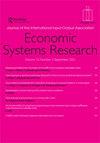基于非线性投入产出分析的主要中等收入国家隐性失业估算(2000-2014
IF 1.6
4区 经济学
Q2 ECONOMICS
引用次数: 1
摘要
本文章由计算机程序翻译,如有差异,请以英文原文为准。
Estimating disguised unemployment in major middle-income countries by means of non-linear input–output analysis, 2000–2014
According to the disguised-unemployment hypothesis, significant wage differences between sectors in less-developed countries result from segmented labour markets and overcrowding of the flexible market segment. So stated, this hypothesis implies a way to measure non-open unemployment: by the amount of labour that must be withdrawn from the market for relative wages to change. Indeed, it is possible to undertake the exercise of comparing the actual employment of a country with a simulated ‘non-dualistic’ employment by means of a non-linear input-output model and taking the US wage structure as a benchmark. This simulation experiment was carried out for seven middle-income countries (Brazil, China, Indonesia, India, Russia, Mexico, and Turkey) using data from the 2016 Release of the World Input–Output Database. The results of the study are consistent with the disguised-unemployment hypothesis, as well as with related literature.
求助全文
通过发布文献求助,成功后即可免费获取论文全文。
去求助
来源期刊

Economic Systems Research
ECONOMICS-
CiteScore
5.60
自引率
4.00%
发文量
17
期刊介绍:
Economic Systems Research is a double blind peer-reviewed scientific journal dedicated to the furtherance of theoretical and factual knowledge about economic systems, structures and processes, and their change through time and space, at the subnational, national and international level. The journal contains sensible, matter-of-fact tools and data for modelling, policy analysis, planning and decision making in large economic environments. It promotes understanding in economic thinking and between theoretical schools of East and West, North and South.
 求助内容:
求助内容: 应助结果提醒方式:
应助结果提醒方式:


